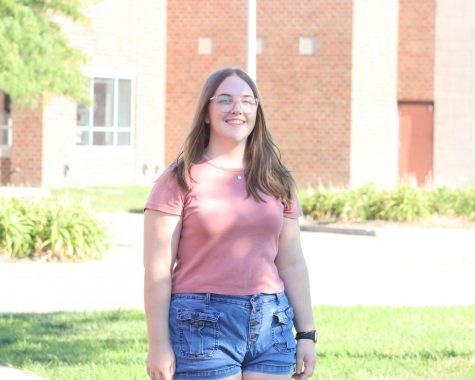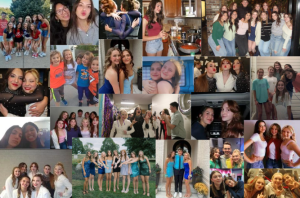Riding along to a future in emergency medicine
Seniors prepare for health science careers during high school
Photo courtesy of Gwyneth Stocker
Health Science Academy students practice their emergency medical skills in class. The EMT class, taken by seniors, teaches them about everything from taking vital signs to delivering babies. “In my academy class to prepare, we have not only learned the textbook content material, but we spend half of the class working on skills like taking vital signs, transporting patients and setting up airway management,” senior Gwyneth Stocker said. “We also, multiple times a week, do scenarios where someone is a patient, and we are told what happened and their injuries so we can practice going through different assessments and working in a real situation.”
March 4, 2022
Seniors in the Health Science Academy are working to obtain their Emergency Medical Technician (EMT) licenses by working with paramedics at the Omaha Fire Department.
Before they obtain their license, students have to meet a few requirements. First, they must pass the EMT course taken through the academy at Horizon High School and complete 24 hours of ambulance ride-along work. Then, they take a national EMT skills test and multiple choice test. If they pass, they will have their Nebraska and national EMT license, allowing them to work as an EMT in any U.S. state.
The EMT course is taken alongside college writing, psychology, pharmacology and a Certified Nursing Assistant course during senior year of the academy. During the nine week course, students spend two hours and 45 minutes each day learning about emergency medicine. Horizon teacher Jerry Olson teaches the class, with guest paramedics also coming in to assist. Multiple times a week, they do roleplays with one student acting as a patient to practice doing scene and injury assessments. They also spend time learning material and putting their newly acquired skills to work.
“The first half of each class is studying all the types of injuries that patients may have in trauma accidents and then the ways to treat those injuries,” Olson said. “The last part of every class involves students learning all the EMT treatment skills, practicing those skills on each other and completing skills testing with Omaha Fire paramedics that also come to class to work with students. The skills they learn include administering breathing help devices, setting up oxygen tanks for use, administering medications, placing patients on longboards and stretchers, administering C collars for neck protection, applying bandages, dressings, tourniquets, splints, and slings, doing CPR, delivering babies, taking blood sugar readings and taking vital signs including blood pressure, heart and breathing rates and communication with patients to learn their health backgrounds. Our students work with all the skills on scene they have practiced in class including doing CPR on actual patients.”
A major component of obtaining their EMT license is participating in ride-alongs on an ambulance with paramedics. It’s an experience that most aspiring EMTs don’t have until college, and it gives seniors an idea of what it’s really like working in the field of emergency medicine.
Senior Gwyneth Stocker has been on three ride-alongs and is scheduled to complete a fourth one on March 17. Before her scheduled shift, she shows up to the fire station, where she stays between calls. When the station gets a call, an alert sounds and announces whether a truck, engine, battalion or medic is needed. If the call is for a medic, Stocker rushes to the ambulance to ride to the scene. On scene, paramedics direct her on what to do. As an EMT-basic student, she is limited to what she can help with; during her three rides, she took vital signs and patient history. The experience gave her an in-depth look at the process from receiving a call to transporting a patient to the hospital. Inevitably, being in an ambulance and witnessing emergency medical situations led to some unique experiences.
“One was a patient who presented with severe abdominal pain, numbness in hands, hyperventilation which was causing them to go in and out of consciousness, and was bleeding for a month,” Stocker said. “To add on top of that they only spoke Spanish which was definitely a barrier. I got to help with taking their blood pressure and blood glucose, but other than that they didn’t know what was going on so we brought them to the hospital. Another somewhat interesting call was for an older woman who they believed to be overdosing on Lorazepam which is an anti-anxiety medication. I helped take vital signs, but there is no medication or antidote for that type of overdose so we had to bring her to the hospital. I also helped apply pressure to a wound for a port site of a dialysis patient who wouldn’t stop bleeding.”
Senior Ashlyn Liudahl has been on four total ride-alongs, each lasting six hours. During the calls, paramedics describe for her in detail what they are doing, which allows her to build on the knowledge and skills from in class. Like Stocker, she was exposed to the intense and unique nature of emergency medicine.
“For my first ride along, there was a hold situation where they wanted an ambulance on scene because a guy locked himself in his shed with a gun and threatened to shoot himself and his wife, so they wanted us on scene just in case he accidentally shot someone,” Liudahl said. “My most recent ride along, there was an assault of a pregnant woman and they wanted us on scene to make sure she was safe and okay. After that we went to jail. One of the prisoners had diabetes and his blood sugar was low; he was going into a seizure state, so we did end up transporting him. We gave him a lot of glucose and food. We had two cops with us to make sure he didn’t try to make a break for it even though he was not fully conscious.”
These experiences serve to give students direct insight into the medical field. For Liudahl, the experience has inspired her to pursue a career in emergency medicine which she hadn’t previously considered. She plans on taking the EMT national exam to get her license. In the fall, she will attend Bryan College of Health Sciences in Lincoln. Its location in a medical center will allow her to continue receiving the hands-on education she has had in the academy, and their 100% acceptance rate for graduate school will help her as she seeks to further her education in medical school. It was her exposure to emergency medicine through the EMT class that inspired her to take that path.
Stocker will be attending the University of Nebraska-Lincoln to study biochemistry and microbiology on the pre-med track. She plans to take the EMT national exam to get her license and have the option to work as an EMT during college. Like Liudahl, she hopes to attend medical school and potentially pursue a career as an orthopedic surgeon.
“I think that the skills and knowledge I have gained through this program and the ride alongs will for sure help in the future,” Stocker said. “This is mostly due to the wealth of knowledge I will have acquired that many people don’t learn until later in their schooling. Also, the patient contact now will make patient contact much easier in the future because I will have already done it before. It definitely makes me more excited for my future in the medical field because now I get to see just how big of an impact I can make on people and the relationships I can build.”
After they have met the other requirements, Health Academy seniors will take the national licensing exam. If they pass, their EMT license will open up opportunities for them in college and in their future medical careers.







